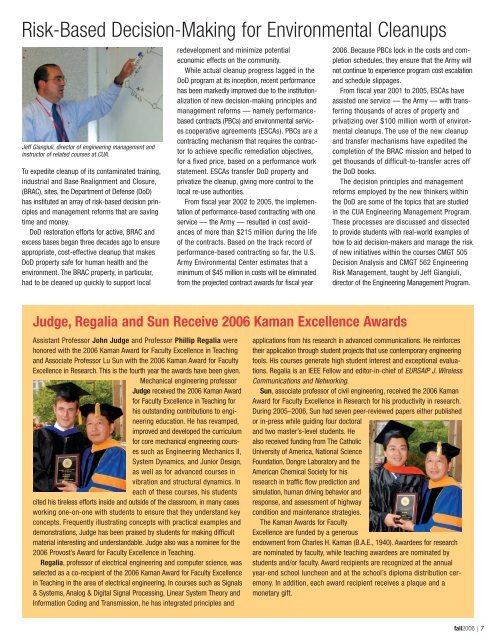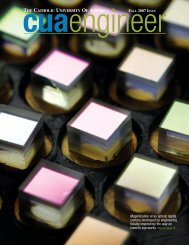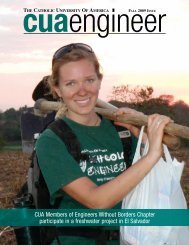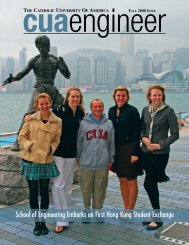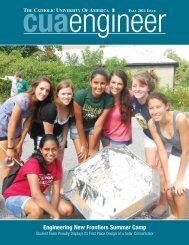inside - the School of Engineering - The Catholic University of America
inside - the School of Engineering - The Catholic University of America
inside - the School of Engineering - The Catholic University of America
You also want an ePaper? Increase the reach of your titles
YUMPU automatically turns print PDFs into web optimized ePapers that Google loves.
Risk-Based Decision-Making for Environmental Cleanups<br />
Jeff Giangiuli, director <strong>of</strong> engineering management and<br />
instructor <strong>of</strong> related courses at CUA.<br />
To expedite cleanup <strong>of</strong> its contaminated training,<br />
industrial and Base Realignment and Closure,<br />
(BRAC), sites, <strong>the</strong> Department <strong>of</strong> Defense (DoD)<br />
has instituted an array <strong>of</strong> risk-based decision principles<br />
and management reforms that are saving<br />
time and money.<br />
DoD restoration efforts for active, BRAC and<br />
excess bases began three decades ago to ensure<br />
appropriate, cost-effective cleanup that makes<br />
DoD property safe for human health and <strong>the</strong><br />
environment. <strong>The</strong> BRAC property, in particular,<br />
had to be cleaned up quickly to support local<br />
redevelopment and minimize potential<br />
economic effects on <strong>the</strong> community.<br />
While actual cleanup progress lagged in <strong>the</strong><br />
DoD program at its inception, recent performance<br />
has been markedly improved due to <strong>the</strong> institutionalization<br />
<strong>of</strong> new decision-making principles and<br />
management reforms — namely performancebased<br />
contracts (PBCs) and environmental services<br />
cooperative agreements (ESCAs). PBCs are a<br />
contracting mechanism that requires <strong>the</strong> contractor<br />
to achieve specific remediation objectives,<br />
for a fixed price, based on a performance work<br />
statement. ESCAs transfer DoD property and<br />
privatize <strong>the</strong> cleanup, giving more control to <strong>the</strong><br />
local re-use authorities.<br />
From fiscal year 2002 to 2005, <strong>the</strong> implementation<br />
<strong>of</strong> performance-based contracting with one<br />
service — <strong>the</strong> Army — resulted in cost avoidances<br />
<strong>of</strong> more than $215 million during <strong>the</strong> life<br />
<strong>of</strong> <strong>the</strong> contracts. Based on <strong>the</strong> track record <strong>of</strong><br />
performance-based contracting so far, <strong>the</strong> U.S.<br />
Army Environmental Center estimates that a<br />
minimum <strong>of</strong> $45 million in costs will be eliminated<br />
from <strong>the</strong> projected contract awards for fiscal year<br />
2006. Because PBCs lock in <strong>the</strong> costs and completion<br />
schedules, <strong>the</strong>y ensure that <strong>the</strong> Army will<br />
not continue to experience program cost escalation<br />
and schedule slippages.<br />
From fiscal year 2001 to 2005, ESCAs have<br />
assisted one service — <strong>the</strong> Army — with transferring<br />
thousands <strong>of</strong> acres <strong>of</strong> property and<br />
privatizing over $100 million worth <strong>of</strong> environmental<br />
cleanups. <strong>The</strong> use <strong>of</strong> <strong>the</strong> new cleanup<br />
and transfer mechanisms have expedited <strong>the</strong><br />
completion <strong>of</strong> <strong>the</strong> BRAC mission and helped to<br />
get thousands <strong>of</strong> difficult-to-transfer acres <strong>of</strong>f<br />
<strong>the</strong> DoD books.<br />
<strong>The</strong> decision principles and management<br />
reforms employed by <strong>the</strong> new thinkers within<br />
<strong>the</strong> DoD are some <strong>of</strong> <strong>the</strong> topics that are studied<br />
in <strong>the</strong> CUA <strong>Engineering</strong> Management Program.<br />
<strong>The</strong>se processes are discussed and dissected<br />
to provide students with real-world examples <strong>of</strong><br />
how to aid decision-makers and manage <strong>the</strong> risk<br />
<strong>of</strong> new initiatives within <strong>the</strong> courses CMGT 505<br />
Decision Analysis and CMGT 562 <strong>Engineering</strong><br />
Risk Management, taught by Jeff Giangiuli,<br />
director <strong>of</strong> <strong>the</strong> <strong>Engineering</strong> Management Program.<br />
Judge, Regalia and Sun Receive 2006 Kaman Excellence Awards<br />
Assistant Pr<strong>of</strong>essor John Judge and Pr<strong>of</strong>essor Phillip Regalia were<br />
honored with <strong>the</strong> 2006 Kaman Award for Faculty Excellence in Teaching<br />
and Associate Pr<strong>of</strong>essor Lu Sun with <strong>the</strong> 2006 Kaman Award for Faculty<br />
Excellence in Research. This is <strong>the</strong> fourth year <strong>the</strong> awards have been given.<br />
Mechanical engineering pr<strong>of</strong>essor<br />
Judge received <strong>the</strong> 2006 Kaman Award<br />
for Faculty Excellence in Teaching for<br />
his outstanding contributions to engineering<br />
education. He has revamped,<br />
improved and developed <strong>the</strong> curriculum<br />
for core mechanical engineering courses<br />
such as <strong>Engineering</strong> Mechanics II,<br />
System Dynamics, and Junior Design,<br />
as well as for advanced courses in<br />
vibration and structural dynamics. In<br />
each <strong>of</strong> <strong>the</strong>se courses, his students<br />
cited his tireless efforts <strong>inside</strong> and outside <strong>of</strong> <strong>the</strong> classroom, in many cases<br />
working one-on-one with students to ensure that <strong>the</strong>y understand key<br />
concepts. Frequently illustrating concepts with practical examples and<br />
demonstrations, Judge has been praised by students for making difficult<br />
material interesting and understandable. Judge also was a nominee for <strong>the</strong><br />
2006 Provost’s Award for Faculty Excellence in Teaching.<br />
Regalia, pr<strong>of</strong>essor <strong>of</strong> electrical engineering and computer science, was<br />
selected as a co-recipient <strong>of</strong> <strong>the</strong> 2006 Kaman Award for Faculty Excellence<br />
in Teaching in <strong>the</strong> area <strong>of</strong> electrical engineering. In courses such as Signals<br />
& Systems, Analog & Digital Signal Processing, Linear System <strong>The</strong>ory and<br />
Information Coding and Transmission, he has integrated principles and<br />
applications from his research in advanced communications. He reinforces<br />
<strong>the</strong>ir application through student projects that use contemporary engineering<br />
tools. His courses generate high student interest and exceptional evaluations.<br />
Regalia is an IEEE Fellow and editor-in-chief <strong>of</strong> EURSAIP J. Wireless<br />
Communications and Networking.<br />
Sun, associate pr<strong>of</strong>essor <strong>of</strong> civil engineering, received <strong>the</strong> 2006 Kaman<br />
Award for Faculty Excellence in Research for his productivity in research.<br />
During 2005–2006, Sun had seven peer-reviewed papers ei<strong>the</strong>r published<br />
or in-press while guiding four doctoral<br />
and two master’s-level students. He<br />
also received funding from <strong>The</strong> <strong>Catholic</strong><br />
<strong>University</strong> <strong>of</strong> <strong>America</strong>, National Science<br />
Foundation, Dongre Laboratory and <strong>the</strong><br />
<strong>America</strong>n Chemical Society for his<br />
research in traffic flow prediction and<br />
simulation, human driving behavior and<br />
response, and assessment <strong>of</strong> highway<br />
condition and maintenance strategies.<br />
<strong>The</strong> Kaman Awards for Faculty<br />
Excellence are funded by a generous<br />
endowment from Charles H. Kaman (B.A.E., 1940). Awardees for research<br />
are nominated by faculty, while teaching awardees are nominated by<br />
students and/or faculty. Award recipients are recognized at <strong>the</strong> annual<br />
year-end school luncheon and at <strong>the</strong> school’s diploma distribution ceremony.<br />
In addition, each award recipient receives a plaque and a<br />
monetary gift.<br />
fall2006 | 7


